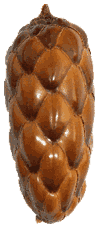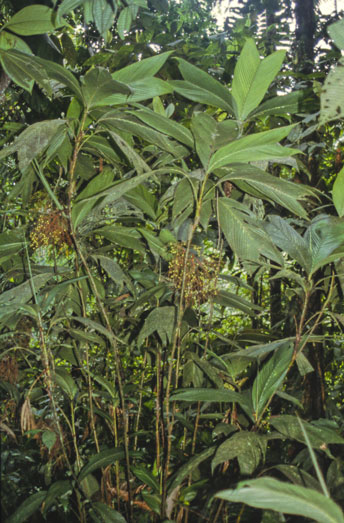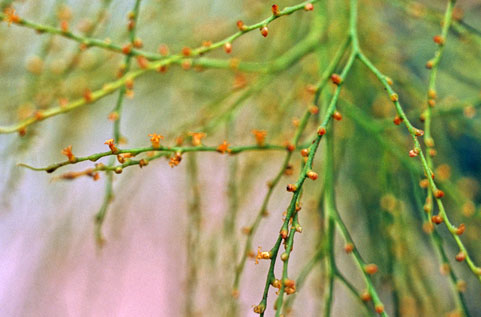 |
Palm |
 |
Palm |
 |
| Habit of Geonoma tenuissima at Torres de Bijagual, Montañas de Ila, western Ecuador. |
Geonoma tenuissima is endemic to the foothills of the Andes in western Ecuador. For many years it was known only from a few sites in the Montañas de Ila, a small range of hilly mountains SW of the city of Santo Domingo de Los Colorados where a number of endemic plant species with extremely restricted range were discovered in the late 1970s before farming activities began to become prominent in the area. The mountain range is not higher than 800–1000 m, separated from the main Andean cordillera by a narrow river valley, but it catches the humidity coming in from the Pacific Ocean in the west resulting in regular cloud cover. Recently, however, the species has been discovered in a similar habitat on a small isolated mountain, not higher than 500 m, some 50 km N of the previously known locality.
It is a small palm with up to 15 slender, clustering stems, ca. 1 cm in diameter and 1 or 2 m tall. The leaf blade is bifid and wedgeshaped. The inflorescence is born below the leaves. It is densely ramified, with slender rachillae of up to three orders, and has widely spaced, conspicuously raised flowerpit. The tiny flowers are orange, quite an unusual colour for the genus. Mature fruits are bright blue, ca. 5 mm in diameter. Taken together, these characters make Geonoma tenuissima clearly distinct from all other palm species in Ecuador. The most similar species occur in NW Colombia and Central America.
 |
| The unusual orange flowers of Geonoma tenuissima. |
Nothing is known about the natural history of the species.
Conversion of forest areas into pasture or plantations is the main threat to the survival of Geonoma tenuissima. The rainforests of western Ecuador are under extreme pressure from agricultural activity and expanding human population. Habitat modelling suggests that up to 92% of the potential habitat for the G. tenuissima has dissappeared. The Montañas de Ila, for many years the only place where this species was known to occur, has suffered severe deforestation over the last 30–40 years, mostly due to small scale farming by colonist families and it is uncertain whether G. tenuissima still occurs there.
The newly located population occurs in a small forest reserve surrounded by oil palm plantations. The species is not known to be in culture anywhere.
A census of the two known populations should be made urgently and a search for additional subpopulations conducted. Initiatives to preserve remaining forest areas within its distribution range should be supported, not only for the sake of G. tenuissima but also for the many other endemic plant species that occur in the same habitat. In vitro conservation may be considered as part of a strategy for preserving the species.
Dr. Finn Borchsenius, Department of Biological Sciences, University of Aarhus, Denmark (finn.borchsenius@biology.au.dk)
Hugo Mogollon, Finding Species, Ecuador (hfmogollon@findingspecies.org)
Borchsenius, F. 1997a.
Patterns of plant species endemism in Ecuador.
Biodiversity and Conservation 6: 379-399.
Borchsenius, F. 1997b.
Palm communities in western Ecuador.
Principes 41: 93-99.
Borchsenius, F. & Skov, F. 1999.
Conservation status of the palms of Ecuador.
Acta Botanica Venezuelana 22: 221-236.
Borchsenius, F., Borgtoft Pedersen, H., and Balslev, H. 1998.
Manual to the palms of Ecuador.
AAU Reports 37, Dept. of Systematic Botany, University of Aarhus (217 pp.).
Mogollon, H., Borchsenius, F. & Skov, F. unpublished data, 2006.
Results from habitat modelling of Ecuadorian palms using Maxent version 2.3 software
(http://www.cs.princeton.edu/~schapire/maxent/)
Moore, H.E. 1982.
Geonoma tenuissima.
Principes 26: 204-205.